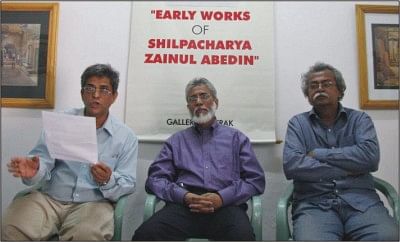Early works of Zainul real treat for first-time viewers

Art critic Moinuddin Khaled reads out a written statement at a press conference at Gallery Chitrok in the city yesterday. On his left are art collector Daud Farhan and Executive Director of the gallery artist Md Moniruzzaman.Photo: STAR
A wooden house, a river bank with rows of boats, an indigenous man in his home, people reaping harvest - the paintings bear an air of poise and pride which are startling for a viewer seeing those for the first time.
Those are the artworks of Shilpacharya Zainul Abedin, the most famous painter of undivided Bengal, was not meticulous to preserve the early works of his life.
Like many other artists, he kept those in a trunk or gave the works away to those who surrounded him.
Fortunately, those people preserved his works like precious gems. Some of the paintings are torn, some are unfinished works and do not have any signatures but carry the same values as the finished ones.
Fifty paintings of Zainul, done in the early years of his life as an artist, adorn the walls of Gallery Chitrok. The exhibition, which will be going on until February 28, is the first of its kind in the country. It is open to all every day from 10:00am to 8:00pm.
Most of the paintings were done between 1930 and 1946 in Mymensingh, Kolkata and Dumki. Many works were done before he had started his student life in 1932 at the Academy of Fine Arts in Kolkata.
These paintings his earlier works before his landmark painting of famine in 1943.
In his student life, Zainul and artist Anwarul Haque became close friends. Zainul frequented the family house of Anwar at 81 Bondel Street.
Many of the paintings were created in this house and later preserved by the members of Anwar's family. It was a wooden house built by his father who imported the wood from Africa.
Zainul had access to the inner part of the house where he sometimes drew pictures for the embroidery and needlework done by the women of the house.
“In this way, many of his valuable pictures were preserved by the women of the house,” said Daud Farhan, nephew of Anwar, who has fifty precious paintings of Zainul from those early years.
“A trunk where he stored his pictures is also an asset of the family,” he added.
The family was very conservative about paintings but everybody loved Zainul because of the beauty of the pictures he had painted. Anwar's father let him study at the art college seeing the wonderful pictures of Zainul.
The pictures of urban life were painted during his stay in Kolkata. The pictures of river, boats, paddy field and rural life were painted during his stay in Mymensingh in 1930 and 1931 and when he went there to spend his vacation.
There are some pictures of indigenous people which were painted during his sojourn at Dumki.
Daud said he has a plan to set up a museum at Shakhipur in Tangail to display these prized works. Besides, a committee can be formed for the management of the pictures.
“I have a desire to create a letter bank too so that the letters written by him can be preserved and displayed,” he added.
Associate Prof of Institute of Fine Arts Nisar Hossain said: “There is no milestone painting in this exhibition. But these paintings represent the early years of the brilliant artist. The water colour and the materials used by him in 1930 is of high qualities which mean he started painting like a professional artist before starting his student life.”
“Some of these paintings do not carry his signatures but critics can easily identify his paintings due to his unique skills,” he added.

 For all latest news, follow The Daily Star's Google News channel.
For all latest news, follow The Daily Star's Google News channel. 



Comments